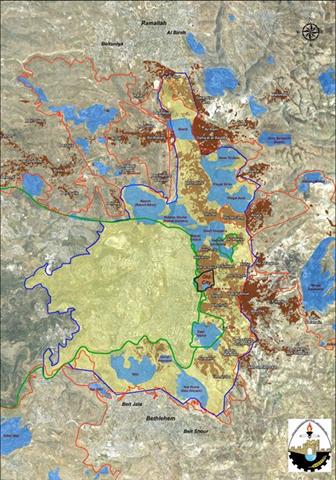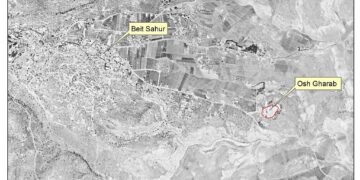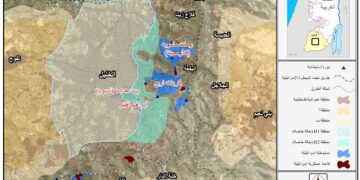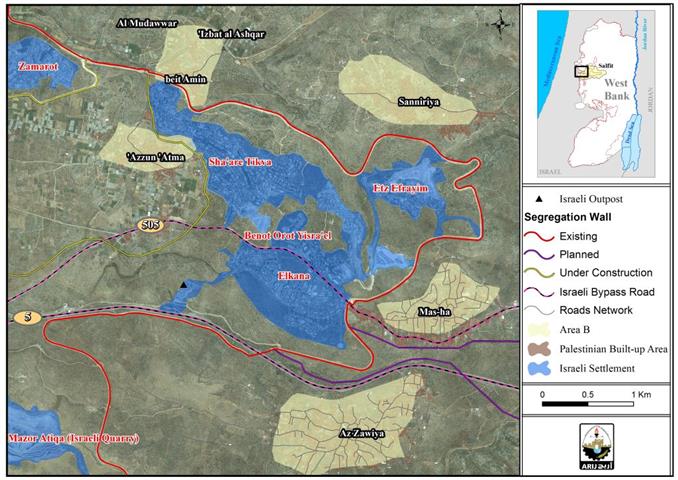On August 28, 2014, the Israeli Municipality of Jerusalem approved a new colonial plan to build a Talmudic Academy “Yeshiva” in the Palestinian Arab neighborhood of Al-Sheikh Jarrah in the eastern part of the city of Jerusalem.
The story of the colonial project started on January 1, 2014 when the Israeli daily newspaper “Haaretz” revealed on its website the plan that holds No. 68858 to build nine storey building Talmudic Academy (with a total area of 9,615 square meter). The plan was initially approved by the Local Planning and Building Committee related to the Israeli Ministry of Interior. Moreover, the Academy is designated for “Ohr Sameach Yeshiva” where it would include 7 stories above the ground and six underground, four of which whill be used as parking lots.
According to the Israeli occupation authorities, the land designated for the project was confiscated back in the 1980s under what is so-called “Absentee Property law of 1950”[1] in which the ownership of the land is transferred to the Israel Land Authority. See Map 1:
Map 1: “Ohr Sameach Yeshiva” project
Inauguration of a New Talmudic Academy in Bab Al-Sahara Arab Neighborhood East of Jerusalem
On September 3, 2014, hundreds of Israeli settlers under the protection of the Israeli Police fled to Al-Sultan Suleiman Street to celebrate the inauguration of a new “Yeshiva” called “ Otzmat Yerushalayim”.
“Ateret Cohanim” an Israeli right-wing and colonial Jewish organization that aims at establishing Jewish communities mainly inside the Palestinian neighborhoods in East Jerusalem, revealed on March 2014 that the organization had bought a significant portion of a building at the heart of the Palestinian commercial plot in the site.
Note that the Building, in which the Yeshiva was established, was confiscated following June 1967 under Absentee Property law of 1950” where two stories from the building were used by the “Israel Post” and another two were used as police station in the site. See Map 2:
Map 2: location of the talmudic Academy in Bab Al-Sahara Arab Neighborhood East of Jerusalem
Colonial Plans motivated by Political & Ideological Goals
Obviously , we can easily find the Israeli decision to build Talmudic Academies in the heart of two Palestinian Arab neighborhoods in the Eastern part of the city of Jerusalem is solely political with the aim of Judazing the Arab neighborhoods in the city.
More than that, the successive Israeli plans to build and expand the illegal settlements and build new ones under religious pretexts “Yeshivas” came in parallel with systematic Israeli campaign to undermine the Palestinian Jerusalemite existence in their communities through demolishing the houses and deliberately neglecting to develop the basic infrastructure while imposing exaggerated taxes and fees.
Legal & International Status
The Israeli colonial activities conducted by the Occupation authorities are illegal and contradicts with the international law rules and conventions :
The existence of the Israeli settlements in the West Bank and their expansions are Illegal and contradicts with the international law rules, United Nations Security Council Resolutions such as 237 (1967), 271 (1969), 446 (1979), 452 (1979) ,465 (1980.
Resolution 446 March 22, 1979 calls on Israel to rescind its previous measures and to desist from taking any action which would result in changing the legal status and geographical nature and materially affecting the demographic composition of the Arab territories occupied since 1967, including Jerusalem and, in particular, not to transfer parts of its own civilian population into the occupied Arab territories"
Also the resolution 452 of the 1979 “calls upon the Government and people of Israel to cease, on an urgent basis, the establishment, construction and planning of settlements in the Arab territories occupied since 1967, including Jerusalem.”
And the International Convention on the Elimination of All Forms of Racial Discrimination (1965)
Article 5 provides that: 'States' Parties undertake to prohibit and eliminate racial discrimination in all of its forms and to guarantee the right of everyone, without distinction as to race, color, or national or ethnic origin, to equality before the law, notably in the enjoyment of the following rights: … (e) in particular … (iii) the right to housing'.
- Article 2 in the Universal Declaration of Human Rights reads that: 'Everyone is entitled to all the rights and freedoms set forth in this Declaration, without distinction of any kind, such as race, color, sex, language, religion, political or other opinion, national or social origin, property, birth or other status. Furthermore, no distinction shall be made on the basis of the political, jurisdictional or international status of the country or territory to which a person belongs, whether it be independent, trust, non-self-governing or under any other limitation of sovereignty.'
- Article 3 states that 'everyone has the right to life, liberty and security of person'.
- Article 13 states also that: Everyone has the right to freedom of movement and residence within the borders of each state.'
- Article 25 states that: Everyone has the right to a standard of living adequate for the health and well-being of himself and of his family, including food, clothing, housing and medical care and necessary social services, and the right to security in the event of unemployment, sickness, disability, widowhood, old age or other lack of livelihood in circumstances beyond his control.
[1] ABSENTEES' PROPERTY LAW, 5710-1950*
http://unispal.un.org/UNISPAL.NSF/0/E0B719E95E3B494885256F9A005AB90A
Prepared by:
The Applied Research Institute – Jerusalem















